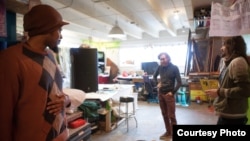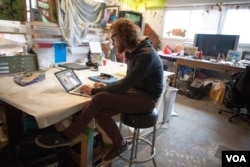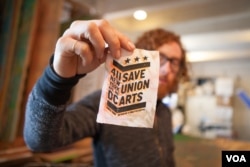Blocks away from Capitol Hill sits a nondescript warehouse in a northeast D.C. neighborhood.
On the first floor behind tall grey-blue metal double doors is a quiet antique shop. The second floor, however, is anything but quiet.
Two towers of PA speakers stand sentinel over a makeshift stage. Under red and blue LED lights, a bass, saxophone and drum jazz trio conducts a sound check, while a noisy crowd forms by the bar.
This is Union Arts D.C., a lively music venue that has hosted hundreds of local, national and international musicians.
It is also an artist-run studio space and sanctuary for independent artists and musicians situated in a rapidly gentrifying neighborhood. NoMa, for North of Massachusetts Avenue, is a warehouse-filled area turned dynamic youth-hipster epicenter.
Share spaces
Over 100 visual artists, musicians and curators call Union Arts home. While only 30 of the residents have signed the lease, many more share spaces and support the larger community that benefits from pro-bono work.
Musician Luke Stewart, who’s nearly as tall as the upright bass he’s playing and almost the same color, says the Union Arts he helped create provides “the opportunity for artists, musicians, to produce their work, to finish their projects, to build a community, to engage and enhance what it is that they do.”
In June 2015, Stewart along with the 30 permanent tenants at Union Arts were informed that the property had been sold to D.B. Lee Development & Construction and Brook Rose Development.
They intend to replace the current structure – a former seed factory, leased to Union Arts for below-market value prices – with a boutique arts hotel, a modern hotel complete with the usual amenities, such as a restaurant, pool and banquet hall.
'Arts hotel'
This “arts hotel” will also have a sculpture terrace, working artist studio space, classrooms and an alley filled with retail spaces and cafes. All that will be left of the original building is the facade.
“We thought about how having a central location for the arts would be kind of a cool thing for the city to have, trying to promote the arts and pull it together,” said Dennis Lee, project lead and president of D.B. Lee Developers & Construction.
“What we hope is to create an interesting unique experience so that everybody will want to come here and then participate in the arts. That’s the sort of authenticity that we’re trying to achieve." said Lee, who grew up in D.C.
But the reality is the artists currently using the space will have to leave. The arts hotel will displace Union Arts.
And for what, asks Stewart, wearing his customary brown Rasta beanie.
“Essentially, what is being created is what I would characterize as a Disneyland-theme-park area of D.C. that is taking a purely organic movement of artists and musicians at Union Arts D.C. and completely taking that energy and that idea and commercializing it for tourists," he said.
Building a community
On stage, Stewart’s mission is to communicate his notions of equality and social justice through the improvised musical vibrations of his bass and synths. From day one at Union Arts, he set out to build a community in D.C. where experimental music can freely communicate political and social ideas.
He wasn’t going to let it go without a fight.
Stewart and several other Union Arts tenants created the Artists Union to preserve the low-cost studio and performance space for young artists in Washington.
On sidewalks, in cafes and in City Hall, they have actively campaigned against the development project. The building is just one of several endangered studio spaces that serve the wider grassroots arts community.
A similar artist-run space, Gold Leaf Studios, closed in 2012.
'Make things happen'
“It’s important to make things happen where you are, especially in D.C. where there is a greater population of people that haven’t been exposed to this music,” said Stewart, who has performed in larger jazz music hubs such as New York City.
Stewart fears that that hotel on New York Avenue will take a cookie-cutter approach to the arts.
CulturalDC, the organization that was chosen by the developers to lead the hotel arts program has a negative reputation in a community of artists that already feels art in D.C. is over-commercialized.
It is very difficult to live in D.C. “as a working artist, as a working musician and that’s because of commercialization,” Stewart said. “A lot of people in order to be here would have to have some sort of compromise for their work.”
The movement to save Union Arts has brought together supporters from both the music and art community, and the social justice movement. The message of the campaign echoes the broader fight in poorer neighborhoods in D.C. where the effects of gentrification and the loss affordable housing are being felt.
“We have to align our fight with the larger fights of the city, like affordable housing, like institutional support from the government, opportunities for people to live and to pursue their passions in the city,” Stewart said.
Remains optimistic
He could move to New York or Chicago, but Stewart remains optimistic about staying in D.C.
The “Save Union Arts” campaign has gained momentum; people have embraced Stewart’s mission. Union Arts has shows lined up until mid-June and Stewart has been approached by supporters to curate a music series and do pop up events.
“I’m not really interested in chasing the next cheat place, chasing the next soon to be hip cool place,” Stewart said. “I’m down to be where I am and build that. I think that’s what it takes ultimately to have the biggest impact in the community. You have to stay put and build it and people will start coming – hopefully.”










